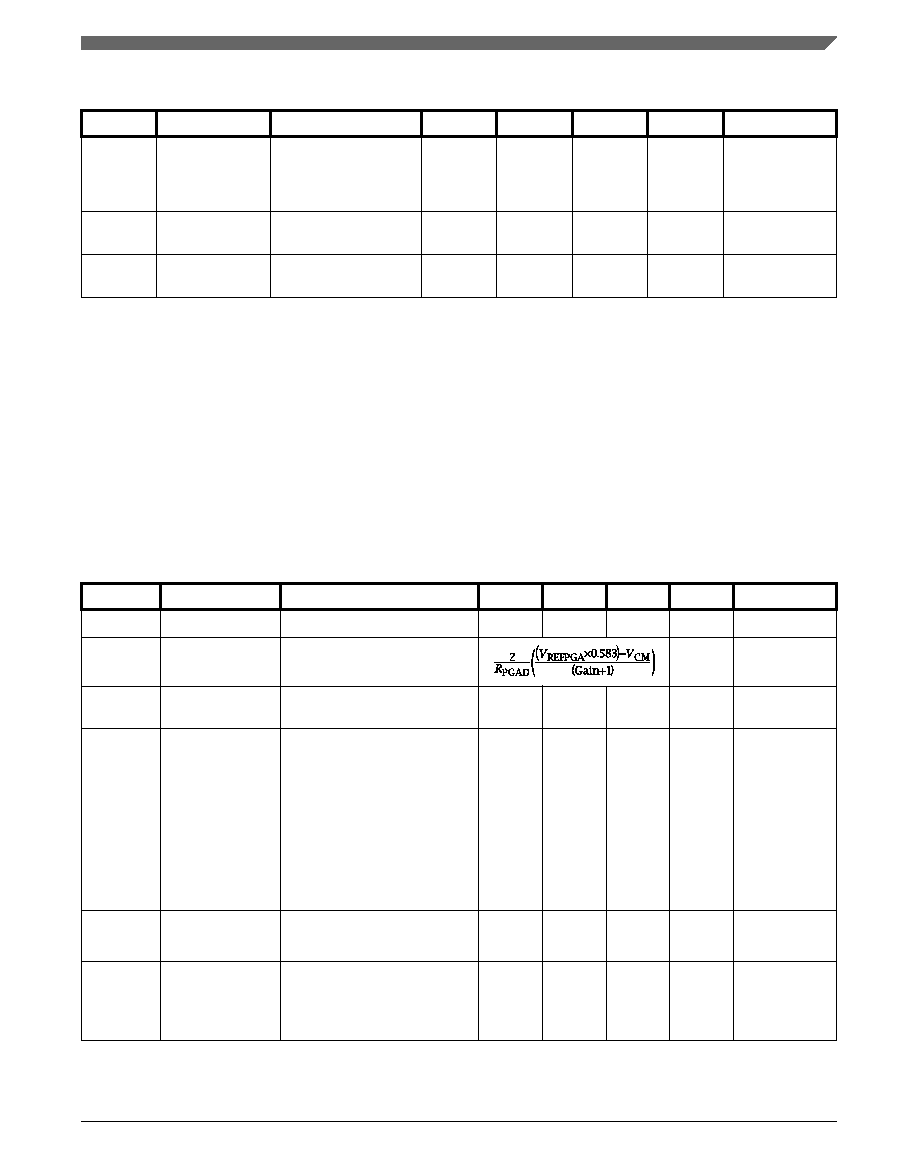- 您現(xiàn)在的位置:買賣IC網(wǎng) > PDF目錄45329 > MK30X256VMD100R (FREESCALE SEMICONDUCTOR INC) 32-BIT, FLASH, 100 MHz, RISC MICROCONTROLLER, PBGA144 PDF資料下載
參數(shù)資料
| 型號: | MK30X256VMD100R |
| 廠商: | FREESCALE SEMICONDUCTOR INC |
| 元件分類: | 微控制器/微處理器 |
| 英文描述: | 32-BIT, FLASH, 100 MHz, RISC MICROCONTROLLER, PBGA144 |
| 封裝: | 13 X 13 MM, MAPBGA-144 |
| 文件頁數(shù): | 38/72頁 |
| 文件大小: | 1847K |
| 代理商: | MK30X256VMD100R |
第1頁第2頁第3頁第4頁第5頁第6頁第7頁第8頁第9頁第10頁第11頁第12頁第13頁第14頁第15頁第16頁第17頁第18頁第19頁第20頁第21頁第22頁第23頁第24頁第25頁第26頁第27頁第28頁第29頁第30頁第31頁第32頁第33頁第34頁第35頁第36頁第37頁當(dāng)前第38頁第39頁第40頁第41頁第42頁第43頁第44頁第45頁第46頁第47頁第48頁第49頁第50頁第51頁第52頁第53頁第54頁第55頁第56頁第57頁第58頁第59頁第60頁第61頁第62頁第63頁第64頁第65頁第66頁第67頁第68頁第69頁第70頁第71頁第72頁

Table 26. 16-bit ADC with PGA operating conditions (continued)
Symbol
Description
Conditions
Min.
Max.
Unit
Notes
RPGAD
Differntial input
impedance
Gain = 1, 2, 4, 8
Gain = 16, 32
Gain = 64
—
128
64
32
—
kΩ
IN+ to IN-4
RAS
Analog source
resistance
—
100
—
Ω
TS
ADC sampling
time
1.25
—
s
1. Typical values assume VDDA = 3.0 V, Temp = 25°C, fADCK = 6 MHz unless otherwise stated. Typical values are for
reference only and are not tested in production.
2. ADC must be configured to use the internal voltage reference (VREFOUT)
3. PGA reference connected to the VREFOUT pin. If the user wishes to drive VREFOUT with a voltage other than the output
of the VREF module, the VREF module must be disabled.
4. For single ended configurations the input impedence of the driven input is 1/2.
5. The analog source resistance (RAS), external to MCU, should be kept as minimum as possible. Increased RAS causes drop
in PGA gain without affecting other performances. This is not dependent on ADC clock frequency.
6. The minimum sampling time is dependent on input signal frequency and ADC mode of operation. A minimum of 1.25s
time should be allowed for Fin=4 kHz at 16-bit differential mode. Recommended ADC setting is: ADLSMP=1, ADLSTS=2 at
8 MHz ADC clock.
6.6.1.4 16-bit ADC with PGA characteristics
Table 27. 16-bit ADC with PGA characteristics
Symbol
Description
Conditions
Min.
Typ.1
Max.
Unit
Notes
IDDA_PGA
Supply current
—
590
TBD
μA
IDC_PGA
Input DC current
A
IILKG
Input Leakage
current
PGA disabled
—
TBD
μA
G
Gain4
PGAG=0
PGAG=1
PGAG=2
PGAG=3
PGAG=4
PGAG=5
PGAG=6
TBD
0.98
1.99
3.97
7.95
15.8
31.4
61.2
TBD
RAS < 100Ω
BW
Input signal
bandwidth
16-bit modes
< 16-bit modes
—
4
40
kHz
PSRR
Power supply
rejection ration
Gain=1
TBD
—
dB
VDDA= 3V
±100mV,
fVDDA= 50Hz,
60Hz
Table continues on the next page...
Peripheral operating requirements and behaviors
K30 Sub-Family Data Sheet Data Sheet, Rev. 4, 3/2011.
Freescale Semiconductor, Inc.
Preliminary
43
相關(guān)PDF資料 |
PDF描述 |
|---|---|
| MK30N512VLQ100R | 32-BIT, FLASH, 100 MHz, RISC MICROCONTROLLER, PQFP144 |
| MK3200G | 0.032768 MHz, OTHER CLOCK GENERATOR, PDSO8 |
| MK3200S | 0.032768 MHz, OTHER CLOCK GENERATOR, PDSO8 |
| MK3200GLF | 0.032768 MHz, OTHER CLOCK GENERATOR, PDSO8 |
| MK3200SI | 0.032768 MHz, OTHER CLOCK GENERATOR, PDSO8 |
相關(guān)代理商/技術(shù)參數(shù) |
參數(shù)描述 |
|---|---|
| MK310E-DC24 | 制造商:OMRON Electronic Components LLC 功能描述: |
| MK3161F | 制造商:Ohmite Mfg Co 功能描述: |
| MK3-1A66C-500W | 制造商:Meder electronics(Standex) 功能描述: |
| MK3-1C90C-500W | 制造商:Meder electronics(Standex) 功能描述: |
| MK31R6F | 制造商:Ohmite Mfg Co 功能描述: |
發(fā)布緊急采購,3分鐘左右您將得到回復(fù)。